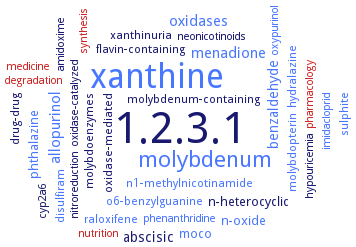1.2.3.1: aldehyde oxidase
This is an abbreviated version!
For detailed information about aldehyde oxidase, go to the full flat file.

Word Map on EC 1.2.3.1 
-
1.2.3.1
-
xanthine
-
molybdenum
-
allopurinol
-
oxidases
-
menadione
-
benzaldehyde
-
abscisic
-
n-oxide
-
n-heterocyclic
-
moco
-
phthalazine
-
raloxifene
-
molybdenum-containing
-
xanthinuria
-
hydralazine
-
oxidase-mediated
-
drug-drug
-
molybdoenzymes
-
sulphite
-
o6-benzylguanine
-
molybdopterin
-
flavin-containing
-
disulfiram
-
n1-methylnicotinamide
-
oxypurinol
-
nutrition
-
medicine
-
hypouricemia
-
amidoxime
-
oxidase-catalyzed
-
pharmacology
-
synthesis
-
degradation
-
cyp2a6
-
nitroreduction
-
imidacloprid
-
neonicotinoids
-
phenanthridine
- 1.2.3.1
- xanthine
- molybdenum
- allopurinol
- oxidases
- menadione
- benzaldehyde
-
abscisic
- n-oxide
-
n-heterocyclic
- moco
- phthalazine
- raloxifene
-
molybdenum-containing
-
xanthinuria
- hydralazine
-
oxidase-mediated
-
drug-drug
-
molybdoenzymes
- sulphite
- o6-benzylguanine
- molybdopterin
-
flavin-containing
- disulfiram
- n1-methylnicotinamide
- oxypurinol
- nutrition
- medicine
-
hypouricemia
-
amidoxime
-
oxidase-catalyzed
- pharmacology
- synthesis
- degradation
- cyp2a6
-
nitroreduction
- imidacloprid
-
neonicotinoids
- phenanthridine
Reaction
Synonyms
Aao4, AHO2, aldehyde oxidase 1, aldehyde oxidase 2, aldehyde oxidase 3, aldehyde oxidase 3-like 1, aldehyde oxidase 4, aldehyde-oxygen oxidoreductase, aldehyde:oxygen oxidoreductase, ALOD, AlOx, antennae-specific aldehyde oxidase, AO, AO-alpha, AO-beta, AO-delta, AO-gamma, AO-kappa, AO1, AO2, AO3, AO4, AOH, AOH1, AOH2, AOH3, AOMM, AOR, AOX, AOX1, AOX2, AOX3, AOX4, AtraAOX2, EC 1.2.3.11, FOD, formate oxidase, IAO1, mAOX3, mouse liver aldehyde oxidase 3, quinoline oxidase, Retinal oxidase, retinene oxidase
ECTree
Advanced search results
Crystallization
Crystallization on EC 1.2.3.1 - aldehyde oxidase
Please wait a moment until all data is loaded. This message will disappear when all data is loaded.
hanging drop vapor diffusion method, using 0.1 M sodium acetate buffer pH 4.6 and 6% (w/v) PEG 4000, at 20°C
-
homology modeling and docking of inhibitors epigallocatchin and epigallocatechin gallate. Interactions include pi-stacking between the phenyl rings of epigallocatchin and residues F923 and F885 and hydrogen bonding between two phenol groups and the carboxylate group on residue E882
-
structure of recombinant aldehyde oxidase at 2.5 A resolution, a narrow funnel leading to the si-face of the isoalloxazine ring of FAD is found. In the molybdenum catalytic centre a tryptophan is situated near the centre instead of the alanine present in other xanthine oxidase family members
Q84IX9; Q84IY0 andQ84IX8
molecular modeling. The structures of the isoforms Aox1 to Aox4 are highly preserved and even more conserved than their amino acid sequences. The binding site is composed by a highly conserved region of the Mo center and ligands, and by residues Gln722, Lys889, Arg917 and Ser1085 (mAOX3 numbering), and by a region, which is different among the several isoforms and is located just above the conserved region. The binding site conserved region is also composed by Phe919 (mAOX3 numbering) and by at least one or two hydrophobic residues containing aromatic rings in their side chains (His, Tyr and Phe)
molecular modeling. The structures of the isoforms Aox1 to Aox4 are highly preserved and even more conserved than their amino acid sequences. The binding site is composed by a highly conserved region of the Mo center and ligands, and by residues Gln722, Lys889, Arg917 and Ser1085 (mAOX3 numbering), and by a region, which is different among the several isoforms and is located just above the conserved region. The binding site conserved region is also composed by Phe919 (mAOX3 numbering) and by at least one or two hydrophobic residues containing aromatic rings in their side chains (His, Tyr and Phe). The mAOX1 isoform has the wider specificity region with a variety of polar and charged amino acids
to 2.9 A resolution, used for elucidation of putative reaction mechanism of aldehyde oxidases
vast majority of the crystallization trials performed using the recombinant protein, usable data set of crystals of native mAOX3 with a resolution of 2.9 A
-


 results (
results ( results (
results ( top
top





